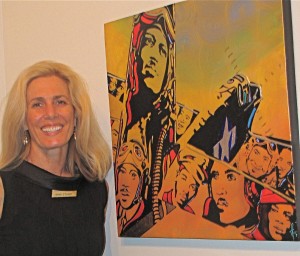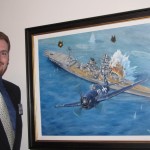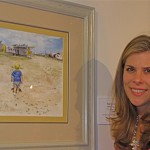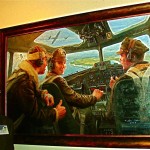By Jack Elliott
Of all the aviation organizations in the country, it may be the most distinguished. Ironically, it is also the least known. There are more members of this organization who enjoy international recognition and fame than any other aviation group in the country. The organization I speak of is the American Society of Aviation Artists (ASAA).

Steve Anderson with his painting “The Bristfits,” a nickname for the Bristol F.2b aircraft flown by the RAF in World War I shown hacking their way through elements of German Richthofens JG1s while Sopwith Camels fight Fokker Triplanes in World War I.
Among those on its long list of distinguished artists is Keith Ferris, who painted the widely acclaimed mural in the Smithsonian National Air and Space Museum in Washington depicting the B-17 Thunder Bird leading a group of 15 aircraft returning from a mission to bomb the Wiesbaden Airfield when they were hit by FW-109s. One squadron below them lost none of its 13 aircraft.
Ferris was one of the founders of the organization, which dates back to 1986. A long-time resident of New Jersey, he is an inductee in the New Jersey Aviation Hall of Fame. Another well-known name in the organization is Sam Lyons. Although he has captured a variety of aircraft on his many canvases, Lyons is best known for his collection of paintings of the venerable Piper Cub. A native of Atlanta, Ga., he was inducted into the Georgia Aviation Hall of Fame this year. Another founder of the ASAA, Robert McCall, is internationally known for his paintings of space. He, like Ferris, has a mural on display at the National Air and Space Museum. It is titled “The Space Mural: A Cosmic View.”

Sam Lyons with his painting “J-3 Morning,” a Piper Cub he once owned. The aircraft is in the hangar awaiting routine maintenance.
Other highly acclaimed ASAA members include Gil Cohen, John Clark, Norman Siegel, Michael O’Neal, Hank Caruso, Kristin Hill, Steve Anderson, Gerald Asher, Paul Rendel, William Phillips and Andy Whyte, just to name a few. The organization also has associate members who, though not artists, are supporters of the contribution ASAA makes to aviation and the world of art.
The ASAA Annual Forum was hosted by the Mighty Eighth Museum in Savannah, Ga., from June 22 to 27, 2009. The juried competition of aviation art which takes place each year remains on exhibit in the museum through December. Only a small percentage of the works submitted are accepted into the competition, making it an exhibition well worth seeing. There is also an unjuried competition—the winners of are selected by attendees.
In back of the museum are the Memorial Gardens, with dozens of plaques commemorating the loss of airmen who served in the Mighty Eighth. There is a chapel to one side of the gardens with some beautiful stained glass windows depicting Mighty Eighth aircraft, and on the far side of the gardens stands a giant B-52.
The 2009 Forum program included lectures and slide presentations by members and guests. John Clark, a former ASAA president, discussed a painting by the French impressionist Gustave Caillebotte. Clark’s talk was fascinating as he delved into every aspect of the artist’s work—the composition, perspective and technique.
The Winners

Mimi Stuart with her painting “Tuskegee Airmen American Royalty,” a tribute to the African-Americans who flew fighter escort for our bombers. Their valor was credited with saving countless American lives.
The Founders’ Associates’ Recognition Awards went to James Waldon for “Stearman” and Kevin Webber for “Spitfire.” Werner Haueptli took the Gold Founders’ Award for his painting “Black and White.” The Silver Founders’ Awards went to Paul Burrows for “Tedium” and Priscilla Messner-Patterson for “Milestones.”
The Matt Jefferies Awards went to Russell Smith for “Hun’s Nightmare” and Kristin Hill for “Another Important Mission,” a work done on site. John Reinhold won the CAE SimuFlite Award for his painting “A Golden Time.” The Women in Aviation Award went to Gerry Asher for “Woman’s Work,” and the Nixon Galloway Award was won by Keith Woodcock for “Speed.”
Ronald Wong took the Windsor Newton Award for “MiG Alley Blues.” The Capt. Duane Whitney Martin Award was taken by Hank Caruso for “Stranded in the Jungle,” and finally the Boeing Spirit of Flight Award went to Gil Cohen for “Almost Home.”
Aviation Week and Space Technology presented a dozen awards. They went to Larry Manofsky, John Clark, Ardell Bourgeois, Wade Meyers, Charles Thompson, Paul Burrows, Sam Lyons, Cher Pruys, Tom Kalina, John Reinhold, Richard Allison, Robert McCauley and Gerry Asher.
- Kevin Weber with his painting “Capt. Bruce Weber – Navy Cross” depicting his uncle pulling up after scoring a direct hit on a Japanese battleship during an attack on Kure Harbor in Japan. Capt. Weber won a Navy Cross for this action.
- Michelle Rouch with her painting “Aspiring Pilot,” showing a small boy walking toward a Grumman Albatross.
- Gil Cohen and his painting “Almost Home”, showing the tremendous relief on the faces of the B-17 cockpit crew as they see the white cliffs of Dover after flying through flak and German fighters on a mission over Germany.














